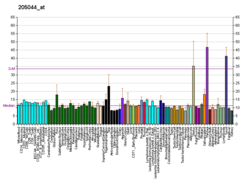| GABRP | |||||||||||||||||||||||||||||||||||||||||||||||||||
|---|---|---|---|---|---|---|---|---|---|---|---|---|---|---|---|---|---|---|---|---|---|---|---|---|---|---|---|---|---|---|---|---|---|---|---|---|---|---|---|---|---|---|---|---|---|---|---|---|---|---|---|
| Identifiers | |||||||||||||||||||||||||||||||||||||||||||||||||||
| Aliases | GABRP , gamma-aminobutyric acid type A receptor pi subunit, gamma-aminobutyric acid type A receptor subunit pi | ||||||||||||||||||||||||||||||||||||||||||||||||||
| External IDs | OMIM: 602729; MGI: 2387597; HomoloGene: 22798; GeneCards: GABRP; OMA:GABRP - orthologs | ||||||||||||||||||||||||||||||||||||||||||||||||||
| |||||||||||||||||||||||||||||||||||||||||||||||||||
| |||||||||||||||||||||||||||||||||||||||||||||||||||
| |||||||||||||||||||||||||||||||||||||||||||||||||||
| |||||||||||||||||||||||||||||||||||||||||||||||||||
| |||||||||||||||||||||||||||||||||||||||||||||||||||
| Wikidata | |||||||||||||||||||||||||||||||||||||||||||||||||||
| |||||||||||||||||||||||||||||||||||||||||||||||||||
Gamma-aminobutyric acid receptor subunit pi is a protein that in humans is encoded by the GABRP gene. [5] [6]
Contents
The gamma-aminobutyric acid (GABA) A receptor is a multisubunit chloride channel that mediates the fastest inhibitory synaptic transmission in the central nervous system. The subunit encoded by this gene is expressed in several non-neuronal tissues including the uterus and ovaries. This subunit can assemble with known GABA A receptor subunits, and the presence of this subunit alters the sensitivity of recombinant receptors to modulatory agents such as pregnanolone. [6]




